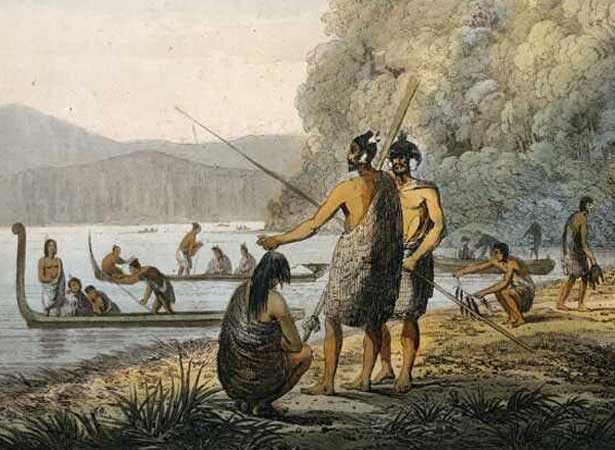
At Wharehunga Bay, Queen Charlotte Sound, 10 men serving under Tobias Furneaux on the sister vessel to James Cook’s Resolution died at the hands of Ngāti Kuia and Rangitāne led by the chief Kahura.
Cook and the Resolution had left the Sounds six days before the Adventure arrived. (The two ships had become separated several weeks earlier during a fierce storm; Ship Cove was the prearranged rendezvous in such an event.) On 17 December Furneaux ordered 10 armed men to go ashore to collect wild greens for the crew. They sailed on a cutter with the master’s mate, Jack Rowe, in charge. Their orders were to return by mid-afternoon, but by nightfall there was still no sign of the cutter.
Next morning Lieutenant James Burney and 10 armed marines set off in a launch to search for the missing cutter and its crew. When they got to a small beach next to ‘Grass Cove’ they spotted a large double-hulled waka (canoe) hauled up on shore. Inside the waka they found one of the cutter’s rowlocks, a shoe belonging to one of the crew, and what they hoped was dog’s flesh. In Between worlds, Anne Salmond described the scene:
Nearby on the beach they saw about twenty food baskets tied up. When they cut these open, they found them packed with roasted meat and fernroot, still warm from the fire. Burney hoped that this might also be dog’s flesh, but soon they found more shoes and a hand tattooed ‘TH’. This was unmistakeably the hand of Thomas Hill…. Behind the beach they saw a circle of freshly dug ground about four feet in diameter, almost certainly a haangi, or earth oven.
The crew hurried back to their launch and rowed to Grass Cove, where they found hundreds of Māori gathered. Some of the crowd taunted the marines, but they quickly dispersed when shots were fired. On the beach they found one of the cutter’s oars and ‘such a shocking scene of Carnage & Barbarity as can never be mentioned or thought of, but with horror’:
Dogs were chewing at the discarded entrails of four or five men, and they found the eyes, hearts, lungs, livers and heads of their comrades … various feet and Rowe’s left hand (identified by its scarred forefinger) roasting on fires or scattered on the ground.
Burney’s crew had probably interrupted a whāngai hau ceremony, in which the participants consume the spirit of an enemy (and his ancestors). The crew quickly collected some of the body parts and hurried back to the launch, firing some parting shots and destroying three waka on the beach. The Adventure sailed early next morning.
Although nobody knows why the Europeans were attacked, Burney concluded that there was probably no premeditation. There had been a few minor incidents and misunderstandings in the preceding days. Jack Rowe, who had previously tried to kidnap local people at Ūawa (Tolaga Bay), may have started a quarrel that got out of hand. Returning to the area three years later during his third voyage to the Pacific, Cook resisted the urgings of his men to take retaliatory action and even hosted Kahura in his cabin.
How to cite this page
'Ten crew from the Adventure killed ', URL: https://nzhistory.govt.nz/ten-crew-of-cooks-ship-em-adventure-em-killed-and-eaten, (Ministry for Culture and Heritage), updated 23-Sep-2020
